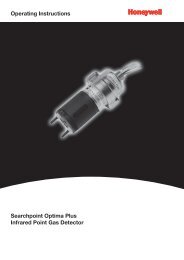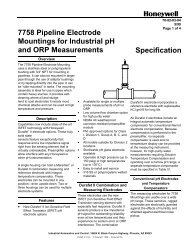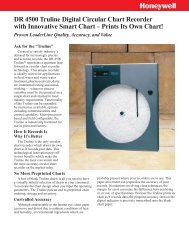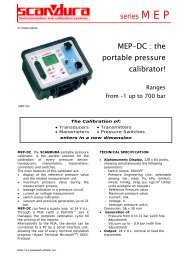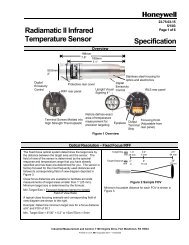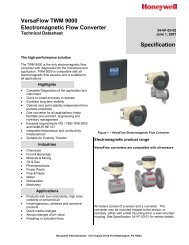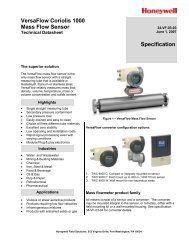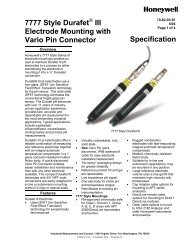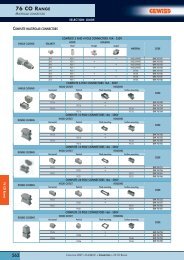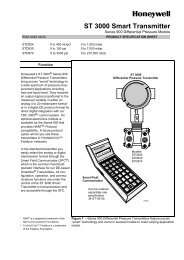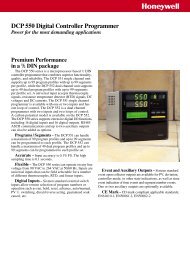PhD6 Multi-Gas Detector Reference Manual - Honeywell Analytics
PhD6 Multi-Gas Detector Reference Manual - Honeywell Analytics
PhD6 Multi-Gas Detector Reference Manual - Honeywell Analytics
Create successful ePaper yourself
Turn your PDF publications into a flip-book with our unique Google optimized e-Paper software.
operation, and the visible and audible alarmscease without further input from the user.Latching alarms can be enabled manuallythrough the Main Menu (see chapter 5), withBioTrak II software or through the IQ6 Dock.1.4.8 Fault detectionPHD6 software includes a number of additionalalarms designed to ensure the proper operationof the instrument. When the PHD6 detects thatan electronic fault or failure condition hasoccurred, the proper audible and visible alarmsare activated and an explanatory message isdisplayed.Faults and other electronic safeguards arediscussed in detail in section 2.5.The PHD6 is designed todetect potentially life threatening atmosphericconditions. Any alarm condition should be takenseriously. The safest course of action is toimmediately leave the affected area, and returnonly after further testing determines that the areais once again safe for entry.1.5 Other electronic safeguardsSeveral automatic programs prevent tamperingand misuse of the PHD6 by unauthorizedpersons. Each time the detector is turned on, thePHD6 automatically tests the LED alarm lights,audible alarm, internal memory and pump status(if so equipped). The battery is monitoredcontinuously for proper voltage. The PHD6 alsomonitors the connection of sensors that arecurrently installed. The detection of anyelectronic faults causes the activation of theaudible and visible alarms and causes the displayof the appropriate explanatory message.1.6 SensorsThe PHD6 can be configured to simultaneouslymonitor oxygen, combustible gases and vapors,volatile organic compounds (VOCs) and anumber of toxic gases. The sensor configurationof the PHD6 may be specified at the time ofpurchase, or changed in the field by appropriatelytrained personnel.The PHD6 must be calibrated following anysensor replacement.Replacement sensor part numbers andsensor ranges are given in Appendix C.A sensor that cannot becalibrated or is found to be out of tolerance mustbe replaced immediately. An instrument that failscalibration may not be used until testing withknown concentration test gas determines thataccuracy has been restored, and the instrumentis once again fit for use.Calibration procedures are discussed in detail inChapter 4.1.6.1 Cross SensitivitySensor cross-sensitivity figures are given inAppendix D.The CO channel in the Duo-Tox sensor in thePHD6 may exhibit high levels of cross sensitivityto organic vapors (VOCs). For best performancein an atmosphere known to contain VOCs, use adedicated CO sensor.1.7 Optional sample draw pumpA motorized sample-draw pump is available forthe PHD6 for situations requiring continuous"hands free" remote monitoring.The PHD6 continuoussample draw pump (part number 54-54-102) isthe only pump that can be used with thePHD6.The pump contains a pressuresensor that detects restrictions inairflow caused by water or otherobstructions being drawn into theunit and immediately acts to turnthe pump off in order to protectthe sensors, pump, and otherPHD6 components fromdamage.Pump status is continuouslymonitored by the PHD6microcontroller. When the pumpis active and functioning properly, the spinningpump icon is displayed in the status bar at thebottom of the display. Low flow or other pumpfault conditions activate audible and visiblealarms and cause the display of the appropriateexplanatory message.1.7.1 Special precautions when using thePHD6 pumpThe rubber material used in the PHD6 diaphragmpump is susceptible to temporary compromise byexposure to high levels of flammable fuel andsolvent vapors. If the PHD6 is being used tosample atmospheres that exceed 50% LEL, testthe pump frequently to ensure that pump functionhas not been compromised.To test the pump, block the end of the samplingline (probe) inlet with a finger. The pump shouldquickly go into alarm, which indicates properfunction. If the pump fails to go into alarm whilethe inlet is blocked, it is not working properly; andthe PHD6 may not be providing an accuratereading. If the pump test fails, the safest courseof action is to immediately leave the affected areaand to return only after further testing with known,functional detection equipment confirms that thearea is once again safe for entry.Do not use the pump tosample for prolonged periods in conditions8



